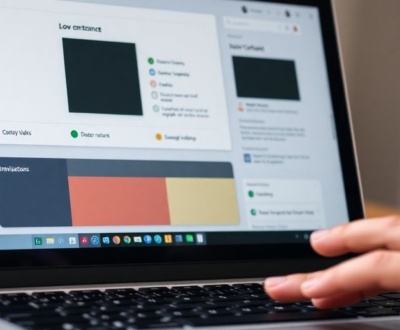It seems like everyone is talking about design these days. You know, how things look and feel when you use them. We all want things to be simple, right? But simple doesn’t mean it can’t do a lot. This article is about finding that sweet spot: making something look really clean and easy to use, while still making sure it does everything you need it to do. It’s about getting a Minimalist UI with maximal UX.
Key Takeaways
- Keep things simple in design, but make sure it still works well.
- Figure out what users really need to do, and make those things easy to find.
- Make sure buttons are clear and give feedback when you click them.
- Use empty space to make things easier to read and understand.
- Make sure your design loads fast and works on all devices.
Defining Minimalist UI with Maximal UX
Minimalist UI design isn’t just about making things look pretty and clean. It’s about creating an experience that’s both simple to use and highly effective. It’s a balancing act, and when done right, it can lead to amazing user experiences. When done wrong, it can be a usability nightmare. Let’s explore how to get it right.
The Core Principles of Simplicity
At its heart, minimalist UI focuses on essential elements. This means stripping away anything that doesn’t directly contribute to the user’s goals. Think of it like decluttering your house – you only keep what you truly need and use. In UI, this translates to fewer buttons, less text, and a more streamlined visual presentation. It’s about making the interface as invisible as possible, so the user can focus on the task at hand.
Beyond Aesthetics: Functionality First
Minimalism isn’t just about looks; it’s about how things work. A beautiful interface is useless if it’s confusing or difficult to navigate. The primary goal should always be to make the user’s journey as smooth and efficient as possible. This means prioritizing functionality and ensuring that every element serves a clear purpose. It’s about creating a system where users can easily find what they need and accomplish their goals without unnecessary distractions.
User Expectations in Modern Design
Users today expect a certain level of intuitiveness and ease of use. They’re used to interacting with apps and websites that are clean, simple, and easy to understand. Failing to meet these expectations can lead to frustration and abandonment. Minimalist design, when executed well, can help meet these expectations by providing a clear and focused user experience. It’s about understanding what users want and need, and then delivering it in the most straightforward way possible.
Minimalist design isn’t about removing everything; it’s about removing the unnecessary. It’s about making conscious choices about what to include and what to leave out, always with the user’s experience in mind.
Strategic Information Prioritization
It’s easy to get carried away and try to cram everything into a minimalist design. But that defeats the whole purpose! You have to be really thoughtful about what information is absolutely necessary for the user to achieve their goals. This section is all about figuring out what to keep, what to cut, and how to present what’s left in a way that makes sense.
Identifying Essential User Journeys
Think about the main reasons people are using your product or visiting your website. What are they trying to accomplish? Map out those key user journeys step-by-step. Once you know the path they need to take, you can focus on providing the information and tools they need along that path, and nothing else. It’s like giving someone directions – you only tell them what they need to know to get to their destination, not the history of every street they pass.
Eliminating Visual Clutter
Visual clutter is the enemy of minimalist design. It overwhelms users and makes it hard for them to focus on what’s important. Get rid of anything that doesn’t directly support the user’s goals. This could mean removing unnecessary graphics, simplifying your color palette, or reducing the number of options available at any given time. Ask yourself: does this element add value, or is it just taking up space?
Progressive Disclosure of Features
Just because a feature exists doesn’t mean it needs to be front and center all the time. Progressive disclosure is a technique where you only reveal features as the user needs them. This keeps the interface clean and simple, while still providing access to more advanced functionality when required. Think of it like this:
- Basic features are always visible.
- Intermediate features are revealed after a user completes a basic task.
- Advanced features are hidden behind a menu or settings panel.
By carefully prioritizing information and using techniques like progressive disclosure, you can create a minimalist UI that is both visually appealing and highly functional. It’s all about giving users what they need, when they need it, and nothing more.
Intuitive Navigation and Interaction
Streamlining User Flows
User flows are super important. Think about it: if people can’t easily find what they’re looking for, they’re just going to leave. The goal is to make the path from point A to point B as smooth as possible. This means cutting out unnecessary steps, reducing the number of clicks, and making sure the overall process feels logical. It’s like planning a road trip – you want the most direct route, not a bunch of detours.
Clear Call-to-Actions
CTAs are the signposts that guide users. They need to be obvious, concise, and tell people exactly what will happen when they click. No one wants to click a button and be surprised by what happens next. Think about using action-oriented language like "Download Now," "Get Started," or "Learn More." Make sure the visual design of the buttons makes them stand out from the rest of the page. A/B testing different CTA designs and wording can help you figure out what works best for your audience.
Feedback Mechanisms for Clarity
Users need to know that their actions have consequences. Did they successfully submit a form? Is something loading? Did an error occur? Feedback mechanisms provide that confirmation. This could be as simple as a loading animation, a success message, or an error notification.
It’s about keeping users informed and in control. If they don’t get feedback, they might assume something went wrong and get frustrated. Clear and timely feedback builds trust and makes the whole experience feel more polished.
Leveraging White Space Effectively
White space, also known as negative space, isn’t just empty space. It’s a powerful design tool that can significantly impact the user experience. It’s about creating balance and harmony, guiding the user’s eye, and improving comprehension. Think of it as the breathing room for your design.
Enhancing Readability and Focus
White space plays a big role in readability. Sufficient space around text makes it easier to scan and digest information. Cramped text is overwhelming and discourages engagement. By strategically using margins, padding, and line spacing, you can create a more comfortable reading experience. This is especially important on mobile devices where screen real estate is limited.
Creating Visual Hierarchy
White space helps establish a clear visual hierarchy. By giving certain elements more space, you draw attention to them. This guides the user through the interface, highlighting important actions and information. Think of it like this: the more space something has, the more important it seems. This is a simple but effective way to prioritize elements without relying solely on size or color.
Reducing Cognitive Load
Too much visual clutter can overwhelm users and increase cognitive load. White space helps to break up the interface, making it less intimidating and easier to process. It gives the user’s brain a chance to rest, preventing fatigue and improving comprehension. A clean, uncluttered design feels more intuitive and less stressful to use.
White space is not wasted space. It’s an investment in user experience. It’s about creating a design that is not only visually appealing but also functional and easy to use. By embracing white space, you can create a more engaging and effective user interface.
Performance as a Design Feature
It’s easy to get caught up in how a website or app looks, but how it performs is just as important, maybe even more so. A beautiful design that takes forever to load or is buggy to use isn’t a good design at all. Performance needs to be a core consideration, not an afterthought.
Optimizing Load Times
Nobody likes waiting. Slow load times can kill user engagement. There are a bunch of things you can do to speed things up. Optimizing images (making them smaller without losing too much quality) is a big one. Also, think about caching – storing frequently accessed data so it doesn’t have to be re-downloaded every time. Minifying CSS and JavaScript files (removing unnecessary characters) can also make a difference.
Responsive Design for All Devices
These days, people are accessing websites on all sorts of devices – phones, tablets, laptops, desktops, even TVs. Your design needs to adapt to all of them. Responsive design isn’t just about making things look good on different screen sizes; it’s about making sure the site works well, too. That means optimizing images for mobile, using touch-friendly controls, and making sure the layout is easy to navigate on a small screen.
Smooth Transitions and Animations
Animations and transitions can make a UI feel more polished and engaging, but they can also hurt performance if they’re not done right. The key is to use them sparingly and efficiently. Avoid animations that are too long or complex, and make sure they’re hardware-accelerated (meaning they’re handled by the graphics card instead of the CPU). This can make a big difference in smoothness, especially on mobile devices.
Performance is part of the user experience. A fast, responsive website feels better to use, and that can have a big impact on user satisfaction and business results. Don’t sacrifice speed for aesthetics. Find the right balance.
The Role of Personalization in Simplicity
Minimalist design isn’t about stripping everything away until you’re left with a blank screen. It’s about making deliberate choices about what to include and how to present it. Personalization plays a big role here. It’s about making the experience feel tailored to the individual user without adding unnecessary complexity. It’s a balancing act, for sure, but when done right, it can make a minimalist interface feel surprisingly rich and intuitive.
Tailoring Experiences Without Overload
One of the biggest challenges with personalization is avoiding feature creep. You don’t want to overwhelm users with options they don’t need or want. The key is to focus on the most relevant aspects of the user’s experience and personalize those. Think about things like preferred language, frequently used features, or content that aligns with their past behavior. It’s about making the interface adapt to them, not the other way around. For example, Samsung UX offers a lot of customization.
Smart Defaults and Customization
Smart defaults are your friend. Pre-selecting options based on common usage patterns or inferred preferences can significantly reduce the cognitive load on the user. But, and this is important, always provide a way for users to customize those defaults. Give them control over their experience, even if they don’t initially realize they want it. Think of it as a safety net – a way for users to fine-tune the interface to perfectly match their needs. Here are some examples of smart defaults:
- Setting the user’s location based on their IP address.
- Suggesting frequently used features based on past behavior.
- Pre-filling forms with information the user has provided before.
Anticipating User Needs
This is where things get really interesting. Can you predict what a user will want to do next? Can you surface relevant information or features before they even have to ask? This requires a deep understanding of your users and their goals. It’s about using data and analytics to identify patterns and anticipate needs. But be careful – don’t be creepy. Transparency is key. Users should always understand why they’re seeing what they’re seeing.
Personalization in minimalist design is about creating a sense of relevance and efficiency. It’s about making the interface feel like it was designed specifically for the user, without sacrificing the simplicity and clarity that are the hallmarks of minimalist design. It’s a subtle art, but when mastered, it can lead to a truly exceptional user experience.
Measuring Success in Minimalist Design
Minimalist design isn’t just about looking good; it’s about achieving specific goals with less. But how do you know if your minimalist design is actually working? It’s all about tracking the right things and making adjustments based on what you find. It’s not enough to just say it looks clean; you need data to back it up.
Key Performance Indicators for UX
When it comes to minimalist UX, some KPIs are more important than others. We’re talking about things like:
- Task Success Rate: Can users actually complete what they came to do? If they can’t, your beautiful design is failing.
- Time on Task: How long does it take them? Shorter is usually better, indicating a smooth, intuitive experience. You can improve this by focusing on streamlining user flows.
- Error Rate: Are users making mistakes? A high error rate suggests confusion or unclear instructions.
These metrics give you a solid foundation for understanding how users interact with your minimalist interface.
User Testing and Iteration
User testing is where the rubber meets the road. You can have all the data in the world, but watching real people use your design is invaluable. Here’s the deal:
- Recruit participants: Find people who represent your target audience.
- Give them tasks: Ask them to complete specific actions within your interface.
- Observe and record: Watch how they interact, noting any struggles or points of confusion.
- Iterate: Use the feedback to make improvements and repeat the process.
User testing doesn’t have to be expensive or complicated. Even simple, informal tests can reveal significant insights. The key is to be open to feedback and willing to make changes based on what you learn. Don’t get too attached to your initial design; be ready to adapt.
Balancing User Satisfaction and Business Goals
Ultimately, a successful minimalist design needs to serve both the user and the business. It’s a balancing act. You want users to be happy and find the interface easy to use, but you also need to achieve business objectives like increased conversions or higher engagement. The sweet spot is where user satisfaction and business goals align. Consider these points:
- Conversion Rates: Are users completing desired actions, like making a purchase or signing up for a newsletter?
- Retention Rates: Are users coming back? A high retention rate suggests they find value in your product or service.
- Customer Satisfaction Scores: Directly ask users about their experience through surveys or feedback forms.
By tracking these metrics, you can ensure that your minimalist design is not only aesthetically pleasing but also contributing to the overall success of your business.
Conclusion
So, what’s the big takeaway here? It’s pretty simple, really. Making a good app or website means you can’t just pick one thing. You can’t just make it look super clean and forget about how people actually use it. And you can’t just pile on features without thinking about how messy that might get. It’s about finding that sweet spot, you know? Like, how can you make something easy to look at, but also make sure it does everything someone needs it to do without a lot of fuss? It takes some thought, and probably some trying things out, but when you get it right, that’s when users are happy. And that’s the whole point, right?
Frequently Asked Questions
What does ‘minimalist UI’ actually mean?
Minimalist UI means making a design super simple, with only the most important stuff on the screen. It’s like cleaning your room and only keeping what you really need. This helps people focus and not get confused.
What is ‘high-functioning UX’ in simple terms?
UX stands for User Experience. It’s about how a person feels when they use a website or app. If the UX is good, it means people can easily do what they want and feel happy about it, even if the design looks very simple.
How can a simple design still be powerful?
It’s a bit like having a clean desk. When there’s less stuff, you can find what you need faster. In design, less clutter means your eyes can quickly spot the important buttons or information, making it easier to use.
How do you decide what to keep and what to remove in a minimalist design?
We figure out what people need to do most often and make those things super easy to find. Then, we hide the less common things, but make sure they’re still there if someone really needs them. It’s like having a secret drawer for extra tools.
What is ‘white space’ and why is it important?
White space is just the empty areas around text and pictures. It’s like the quiet parts in a song. It helps your eyes rest and makes the important parts stand out, so everything is easier to read and understand.
How do you know if a minimalist design is working for users?
We watch how people use the design, ask them questions, and look at numbers like how fast they finish a task. If they can do what they want quickly and without getting stuck, then we know the simple design is working well.
About this blog
We are a digital marketing company with a focus on helping our customers achieve great results across several key areas.
Request a free quote
We offer professional SEO services that help websites increase their organic search score drastically in order to compete for the highest rankings even when it comes to highly competitive keywords.









